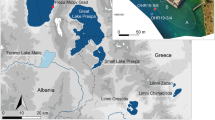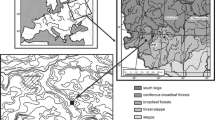Abstract
Palynological analyses of Holocene deposits located about 2 km to the southwest of the Lake Chaohu, Anhui Province, documented well the local vegetation history, its inferred environment and human impacts for the first time. An evergreen and deciduous mixed broad-leaved forest dominated by Cyclobalanopsis and Quercus existed from ca. 10,500 cal b.p. and became fully developed between ca. 8,250 and 7,550 cal b.p. Notable fluctuations occurred in the main components of the flora indicated by the decline in Cyclobalanopsis and other arboreal plants (AP), and an increase in terrestrial herbs between ca. 7,550 and 3,750 cal b.p., inferring the progressive opening of the forest under considerable human interference, which largely agrees with the archaeological evidence. After ca. 3,750 cal b.p., the broad-leaved forest largely gave way to terrestrial herbs, and never again recovered. Pinus continued to rise alongside the majority of herbs between ca. 3,750 and 2,000 cal b.p., then also declined after ca. 2,000 cal b.p. Human influence on the natural vegetation displayed in the pollen diagram seems to increase greatly up the core. The disappearance of broad-leaved forest indicates significant human impact after ca. 3,750 cal b.p., which is consistent with both the archaeological evidence and historical records. From that time the natural environment in the study area was subjected to long-standing pressure from increasing farming and population.




Similar content being viewed by others
References
Behre KE (1981) The interpretation of anthropogenic indicators in pollen diagrams. Pollen et Spores 23:225–245
Behre KE (1986) (ed) Anthropogenic indicators in pollen diagrams. Balkema, Rotterdam
Beug HJ (2004) Leitfaden der Pollenbestimmung für Mitteleuropa und angrenzende Gebiete. Pfeil, München
Du L, Yi ZL, Pan SM (2004) Grain-size characteristics and sedimentary environment in the lacustrian deposit of Chaohu Lake, the Yangtze Delta region. J Anhui Normal Univ (Nat Sci) 27:101–104 (in Chinese with English abstract)
Du Y (2002) Neolithic ashes and historical environment in the Dongting Lake area. J Central China Normal Univ (Nat Sci) 36(4):516–520 (in Chinese with English abstract)
Faegri K, Iversen J (1989) Textbook of pollen analysis, 4th edn. Wiley, Chichester
Fan B, Xu S, Yu L, Jiang H, Ran LH (2006) Phytolith in the sediment of the Lake Chaohu since Middle Holocene and its paleoenvironmental implications. J Lake Sci 18(3):273–279 (in Chinese with English abstract)
Gao MH (2004) Archaeological geography on the lower reaches of the Yangtse River. Fudan University Press, Shanghai (in Chinese with English abstract)
Grimm EC (1990) TILIA and TILIA. GRAPH. PC spreadsheet and graphics software for pollen data. INQUA, Working Group on Data-handling. Meth Newslett 4:5–7
Hong XQ (1989) Low temperature climate and sea level changes during Holocene. In: Yang ZG, Lin HM (eds) Quaternary progress and events in China offshore and onshore area. China Ocean Press, Beijing, pp 111–116 (in Chinese with English abstract)
IB, SCIB (Institute of Botany, South China Institute of Botany, Chinese Academy of Sciences) (1982) Angiosperm pollen flora of tropic and subtropic China. Science Press, Beijing (in Chinese)
Jiang QH, Piperno DR (1999) Environmental and archaeological implications of a late quaternary palynological sequence, Poyang Lake, South China. Quatern Res 52:250–258
JIB (Jiangsu Institute of Botany) (1982) Jiangsu flora. Jiangsu Science and Technology Press, Nanjing (in Chinese)
Kangur M (2002) Methodological and practical aspects of the presentation and interpretation of microscopic charcoal data from lake sediments. Veget Hist Archaeobot 11:289–294
Kong ZC, Liu CJ, Zhang JZ, Jin GY (2003) Plant relics in the Neolithic sites of China and origin of agriculture. Cult Relics Central China 2:4–13 (in Chinese with English abstract)
Li HM, Li WY, Liu JL (1995) Quaternary floras. In: Li XX, Zhou ZY, Cai CY, Sun G, Ouyang S, Deng LH (eds) Fossil floras of China through the geological ages. Guangdong Science and Technology Press, Guangzhou, pp 552–588 (in Chinese)
Li WY (1962) Sporo-pollen analysis of the peat bed of the Tungting Formation and its geological age and problem of palaeogeography. Acta Geograph Sin 28:54–71 (in Chinese with English abstract)
Li WY, Yao ZJ, Liang YL (1993) Pollen quantitative analysis of Quercus and Quercus forests in the Shennongjia Mt. In: Li WY, Yao ZJ (eds) Late quaternary vegetation of North and middle subtropical tegion of China. China Ocean Press, Beijing, pp 14–26 (in Chinese with English abstract)
Liu GX (1993) Late-Glacial and Post-Glacial vegetation and association environment in Yangtze-Han Plain. In: Li WY, Yao ZJ (eds) Late quaternary vegetation of north and middle subtropical region of China. China Ocean Press, Beijing, pp 54–61 (in Chinese with English abstract)
Liu KB, Sun SC, Jiang XH (1992) Environmental change in the Yangtze River Delta since 12000 years B·P. Quatern Res 38:32–45
Marziani G, Citterio S (1999) The effects of human impact on the arboreal vegetation near ancient iron smelting sites in Yal Gabbia, northern Italy. Veget Hist Archaeobot 8:225–229
Moore PD, Webb JA, Collinson ME (1991) Pollen analysis, 2nd edn. Blackwell, Oxford
Okuda M, Sato Y, Tang LH, Takahashi M, Toyama S, Yano A, Kitagawa H, Yasuda Y (2003) Late Holocene vegetation and environment at Cauduntou, west of Yangtze Delta, SW Jiangsu Province, East China. Quatern Int 105:39–47
Reimer PJ, Baillie MGL, Bard E, Bayliss A, Beck JW, Bertrand C, Blackwell PG, Buck CE, Burr G, Cutler KB, Damon PE, Edwards RL, Fairbanks RG, Friedrich M, Guilderson TP, Hughen KA, Kromer B, McCormac FG, Manning S, Bronk Ramsey C, Reimer RW, Remmele S, Southon JR, Stuiver M, Talamo S, Taylor FW, Plicht J, van der Weyhenmeyer CE (2004) IntCal04 Terrestrial Radiocarbon Age Calibration, 0–26 Cal Kyr B·P. Radiocarbon 46:1029–1058
Ren QK, Zhang JZ (2005) The review and prospect of the prehistorical paddy agriculture study in Anhui Province). Agric Archaeol 1:156–160
Sakaguchi Y (1983) Warm and cold stages in the past 7600 years in Japan and their global correlation. Dept Geogr Bull Univ Tokyo 15:1–31
Shi YF, Kong ZC, Wang SM, Tang LY, Wang FB, Yao SG, Zhao XT, Zhang PY, Shi SH (1992) The climate variation and important events in Holocene Megathemal in China. Sci China (Ser B) 12:1300–1308 (in Chinese)
Shou YG, Yang FS, Wang XY (2006) Examination and explanation for the history of Chao residence. Chaohu Coll J 8:72–78 (in Chinese)
Shu JW, Wang WM, Chen W (2007) Holocene vegetation and environment changes in the NW Taihu Plain, Jiangsu Province, East China. Acta Micropalaeontol Sin 24(2):210–221 (in Chinese with English abstract)
Stuiver M, Reimer PJ (1993) Extended 14C data base and revised Calib 3.0 14C age calibration program. Radiocarbon 35:215–230
Tang LY (1992) The Holocene Megathermal vegetation and climate in north Jiangsu. In: Shi YF, Kong ZC (eds) The holocene magathermal climate and environment in China. China Ocean Press, Beijing (in Chinese)
Tang LY, Shen CM, Yu G, Hang HY, Xiao JY (1996) Evidence of the holocene megathermal in the middle and lower reaches of the Yangtze River. In: Zhan PY (ed) Climate change in China during historical times. Shangdong Science and Technology Press, Jinan, pp 125–139 (in Chinese)
Tweddle JC, Edwards KJ, Fieller NRJ (2005) Multivariate statistical and other approaches for the separation of cereal from wild Poaceae pollen using a large Holocene dataset. Veget Hist Archaeobot 14:15–30
Wang FX, Qian NF, Zhang YL, Yang HQ (1995) Pollen Flora of China, 2nd edn. Science Press, Beijing (in Chinese)
Wang KF (1974) Palynological analysis peat-bogs of Siyao Lake, Mountain Hsishan, Nanchang, Kiangsi Province. Acta Bot Sin 16:83–93 (in Chinese with English abstract)
Wang KF, Zhang YL, Jiang H, Hang XB (1984) Palynological assemblages from the Holocene sediments of the Yangtze River Delta and their geological significance. Mar Geol Quatern Geol 4:171–188 (in Chinese with English abstract)
Wang KF, Zhang YL, Jiang H, Wu GX, Wang JW (1993) Holocene pollen assemblages from the Middle and Lower Yangtze River Basin since Pleistocene. In: Commission on quaternary glaciology and geology of the Geological Society of China Geological Society of Jiangsu Province. Contribution to the quaternary glaciology and quaternary geology (8). Geological Publishing House, Beijing, pp 8–29 (in Chinese)
Wang KF, Zhang YL, Feng WQ, Huang XP, Zhang MH (1996) Researches on relationship among Holocene vegetation, environment evolution and human activities in Shanghai region. Mar Geol Quatern Geol 16:1–4 (in Chinese with English abstract)
Wang SW, Gong DY (2000) The temperature of some typical period during the Holocene in China. Progr Nat Sci 10(4):325–332 (in Chinese)
Wang XY, He H, Qian YC, Lu YC, Gao C (2005) A inference of ancient Juchao city based on environment archaeology. J Anhui Normal Univ (Nat Sci) 28(1):97–102 (in Chinese with English abstract)
Wu C, Cao KP (2000) The prehistoric environment in the Yangtze Delta. Southeast Cult 9:6–12 (in Chinese)
Wu JM (1988) The relation of the environmental variance with distribution of the prehistorical sites in Yangtze Delta. Southeast Cult 6:16–35 (in Chinese)
Wu WT (1983) Holocene palaeogeography along the Hangzhou Bay as constructed on the basis of Neolithic culture remains. Acta Geogr Sin 38:113–127 (in Chinese with English abstract)
Wu ZY (1995) Vegetation of China. Science Press, Beijing (in Chinese)
Xiao JY, Wang J, An ZS, Wu XH, Zhou WJ (2000) Evidence for the Younger Dryas events in the eastern past of Nanling region. Acta Micropalaeontol Sin 17:171–177 (in Chinese with English abstract)
Xu X, Zhu ML (1984) Palaeovegetation and palaeoclimate changes in Zhengjiang during the last 15000 years. Geogr Sci Sin 39:175–185 (in Chinese)
Xu XM, Chang WYB, Liu JL (1996) Changes in vegetation and climate in the Taihu Lake Basin during the last 11 000 years. Acta Paleontol Sin 35:186–196 (in Chinese with English abstract)
Yang LX (2002) The review and ponderation of 20th century archeology in Anhui Province. Archeology 2:3–13
Yi S, Saito Y, Oshima H, Zhou YQ, Wei HL (2003a) Holocene environmental history inferred from pollen assemblages in the Huanghe (Yellow River) delta, China: climatic change and human impact. Quatern Sci Rev 22:609–628
Yi S, Saito Y, Zhao QH, Wang PX (2003b) Vegetation and climate changes in the Changjiang (Yangtze River) Delta, China, during the past 13, 000 years inferred from pollen records. Quatern Sci Rev 22:1501–1519
Zhang YL, Xi YZ, Zhang JT, Gao GZ, Du NQ, Sun XJ, Kong ZC (1990) Spore morphology of chinese pteridophytes. Science Press, Beijing
Zhao XT, Tang LY, Shen CM, Wang SH (1994) The Holocene climate changes and sea level variety from the Qingfeng section in Jianhu, Jiangxu. Acta Oceanol Sin 16:78–88 (in Chinese)
Zhen MC (1988) Relations between quaternary climatic fluctuation around Dongting Lake and sporopollen assemblages in Hanshou area. In: Commission on quaternary glaciology and geology of the Geological Society of China Geological Society of Jiangsu Province. Contribution to the quaternary glaciology and quaternary geology (5). Geological Publishing House, Beijing, pp 90–93 (in Chinese)
Zheng Z (1991) Pollen flora and paleoclimate of the Chao-Shan plain during the last 50,000 years. Acta Micropalaeontol Sin 8:464–480 (in Chinese with English abstract)
Zheng Z (2000) Late Quaternary vegetation and climatic changes in the tropical and subtropical areas of China. Acta Micropalaeontol Sin 17:125–146 (in Chinese with English abstract)
Zheng Z, Lei QY (2000) Vegetation, climate and sea level in the past 55, 000 years, Hanjiang Delta, southeastern China. Quatern Res 53:330–340
Acknowledgments
The authors thank Ms. Cui-Ling He for sample analyses. Thanks are also due to Karl-Ernst Behre, Felix Bittmann, Yan Zhao and other reviewers for their helpful suggestions to improve our text. This project is supported by the National Science Foundation of China (40271107; 40571152), and the VolkswagenStiftung’s grant (I/78 365).
Author information
Authors and Affiliations
Corresponding author
Additional information
Communicated by K.-E. Behre.
Rights and permissions
About this article
Cite this article
Chen, W., Wang, WM. & Dai, XR. Holocene vegetation history with implications of human impact in the Lake Chaohu area, Anhui Province, East China. Veget Hist Archaeobot 18, 137–146 (2009). https://doi.org/10.1007/s00334-008-0173-7
Received:
Accepted:
Published:
Issue Date:
DOI: https://doi.org/10.1007/s00334-008-0173-7




